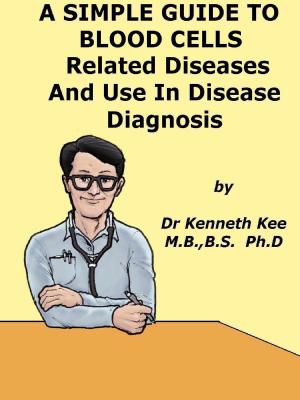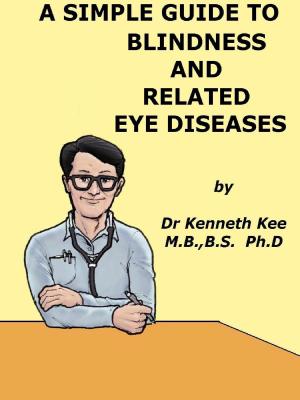Lymphadenopathy, A Simple Guide To The Condition, Diagnosis, Treatment And Related Conditions
Nonfiction, Health & Well Being, Medical, Specialties, Internal Medicine, Hematology, Oncology| Author: | Kenneth Kee | ISBN: | 9781370281367 |
| Publisher: | Kenneth Kee | Publication: | May 25, 2017 |
| Imprint: | Smashwords Edition | Language: | English |
| Author: | Kenneth Kee |
| ISBN: | 9781370281367 |
| Publisher: | Kenneth Kee |
| Publication: | May 25, 2017 |
| Imprint: | Smashwords Edition |
| Language: | English |
Lymph nodes are small, bean-shaped glands present throughout the body.
They are part of the lymph system, which carries the lymph fluid, nutrients, and waste substances between the body tissues and the bloodstream.
The lymph system is an essential part of the immune system, the defense system of the body against disease.
The lymph nodes filter lymph fluid as it passes through them, trapping bacteria, viruses, and other foreign substances, which are then destroyed by lymphocytes (special forms of white blood cells).
Lymph nodes may be found singly or in groups.
The lymph node may be so small like the head of a pin or as large as an olive.
Clusters of lymph nodes can be felt in the neck, groin, and underarms.
Lymph nodes normally are not painful or tender.
Most lymph nodes in the body cannot be felt.
Swollen lymph nodes frequently occur in one location where an injury, infection, or tumor forms near or in the lymph node.
Finding which lymph nodes are swelling can assist in detecting the problem.
The lymph nodes on either side of the neck, behind the ears, or under the jaw, frequently become swollen when the patient has caught a cold or develops sore throat.
The lymph nodes can also become swollen after an injury such as a laceration or wound near the lymph node or when a tumor or infection forms in the mouth, head, or neck.
The lymph nodes in the armpit (axillary) may swell from an infection or injury to the arm or hand.
An occasional cause of axillary swelling may be due to lymph node involvement in breast cancer or lymphoma.
The lymph nodes in the groin (inguinal) may become swollen as a result of spread of germs from an injury or infection in the foot, leg, groin, or genitals.
Rarely, certain cancers such as testicular cancer, lymphoma, or melanoma may produce a swollen lymph node in this region.
The lymph nodes that are above the collarbone (supraclavicular) may become swollen from an infection or tumor in the regions of the lungs, breasts, neck, or abdomen.
The lymph nodes are clusters of lymphatic cells present with some extracellular matrix that are not surrounded by a connective tissue capsule.
They contain proliferating B-lymphocytes and some macrophages.
T-lymphocytes are located outside the germinal center.
They filter the germs and attack the antigens.
In some areas of the body, many lymphatic nodules cluster together to form larger structures
Lymph nodes are found throughout the body.
They are an important part of the immune system.
The lymph nodes assist the body detects and fight the germs, infections, and other foreign bodies.
The term "swollen glands" refers to enlargement of one or more lymph nodes.
The medical term for swollen lymph nodes is lymphadenopathy.
In a child, a node is considered enlarged if it is more than 1 centimeter (0.4 inch) wide.
Frequent areas where the lymph nodes can be palpated (felt) with the fingers) are:
1. Groin
2. Armpit
3. Neck (there is a chain of lymph nodes on either side of the front of the neck, both sides of the neck, and along each side of the back of the neck)
4. Under the jaw and chin
5. Behind the ears
6. At the back of the head
Causes
Infections are the most frequent cause of swollen lymph nodes.
Infections that can cause them are:
1. Abscessed or impacted tooth
2. Ear infection
3. Colds, flu, and other infections
4. Gingivitis
5. Mononucleosis
6. Mouth sores
7. Sexually transmitted illness
8. Tonsillitis
9. Tuberculosis
10. Skin infections
Other than swollen lymph nodes, blood tests, an ultrasound scan or computerized tomography (CT) scan, and a biopsy may be needed.
The treatment is dependent on the cause of the swollen nodes.
Swollen lymph glands are normally a sign of infection or cancer.
TABLE OF CONTENT
Introduction
Chapter 1 Lymphadenopathy
Chapter 2 Causes
Chapter 3 Symptoms
Chapter 4 Diagnosis
Chapter 5 Treatment
Chapter 6 Prognosis
Chapter 7 Lymphadenitis
Chapter 8 Lymphoma
Epilogue
Lymph nodes are small, bean-shaped glands present throughout the body.
They are part of the lymph system, which carries the lymph fluid, nutrients, and waste substances between the body tissues and the bloodstream.
The lymph system is an essential part of the immune system, the defense system of the body against disease.
The lymph nodes filter lymph fluid as it passes through them, trapping bacteria, viruses, and other foreign substances, which are then destroyed by lymphocytes (special forms of white blood cells).
Lymph nodes may be found singly or in groups.
The lymph node may be so small like the head of a pin or as large as an olive.
Clusters of lymph nodes can be felt in the neck, groin, and underarms.
Lymph nodes normally are not painful or tender.
Most lymph nodes in the body cannot be felt.
Swollen lymph nodes frequently occur in one location where an injury, infection, or tumor forms near or in the lymph node.
Finding which lymph nodes are swelling can assist in detecting the problem.
The lymph nodes on either side of the neck, behind the ears, or under the jaw, frequently become swollen when the patient has caught a cold or develops sore throat.
The lymph nodes can also become swollen after an injury such as a laceration or wound near the lymph node or when a tumor or infection forms in the mouth, head, or neck.
The lymph nodes in the armpit (axillary) may swell from an infection or injury to the arm or hand.
An occasional cause of axillary swelling may be due to lymph node involvement in breast cancer or lymphoma.
The lymph nodes in the groin (inguinal) may become swollen as a result of spread of germs from an injury or infection in the foot, leg, groin, or genitals.
Rarely, certain cancers such as testicular cancer, lymphoma, or melanoma may produce a swollen lymph node in this region.
The lymph nodes that are above the collarbone (supraclavicular) may become swollen from an infection or tumor in the regions of the lungs, breasts, neck, or abdomen.
The lymph nodes are clusters of lymphatic cells present with some extracellular matrix that are not surrounded by a connective tissue capsule.
They contain proliferating B-lymphocytes and some macrophages.
T-lymphocytes are located outside the germinal center.
They filter the germs and attack the antigens.
In some areas of the body, many lymphatic nodules cluster together to form larger structures
Lymph nodes are found throughout the body.
They are an important part of the immune system.
The lymph nodes assist the body detects and fight the germs, infections, and other foreign bodies.
The term "swollen glands" refers to enlargement of one or more lymph nodes.
The medical term for swollen lymph nodes is lymphadenopathy.
In a child, a node is considered enlarged if it is more than 1 centimeter (0.4 inch) wide.
Frequent areas where the lymph nodes can be palpated (felt) with the fingers) are:
1. Groin
2. Armpit
3. Neck (there is a chain of lymph nodes on either side of the front of the neck, both sides of the neck, and along each side of the back of the neck)
4. Under the jaw and chin
5. Behind the ears
6. At the back of the head
Causes
Infections are the most frequent cause of swollen lymph nodes.
Infections that can cause them are:
1. Abscessed or impacted tooth
2. Ear infection
3. Colds, flu, and other infections
4. Gingivitis
5. Mononucleosis
6. Mouth sores
7. Sexually transmitted illness
8. Tonsillitis
9. Tuberculosis
10. Skin infections
Other than swollen lymph nodes, blood tests, an ultrasound scan or computerized tomography (CT) scan, and a biopsy may be needed.
The treatment is dependent on the cause of the swollen nodes.
Swollen lymph glands are normally a sign of infection or cancer.
TABLE OF CONTENT
Introduction
Chapter 1 Lymphadenopathy
Chapter 2 Causes
Chapter 3 Symptoms
Chapter 4 Diagnosis
Chapter 5 Treatment
Chapter 6 Prognosis
Chapter 7 Lymphadenitis
Chapter 8 Lymphoma
Epilogue















